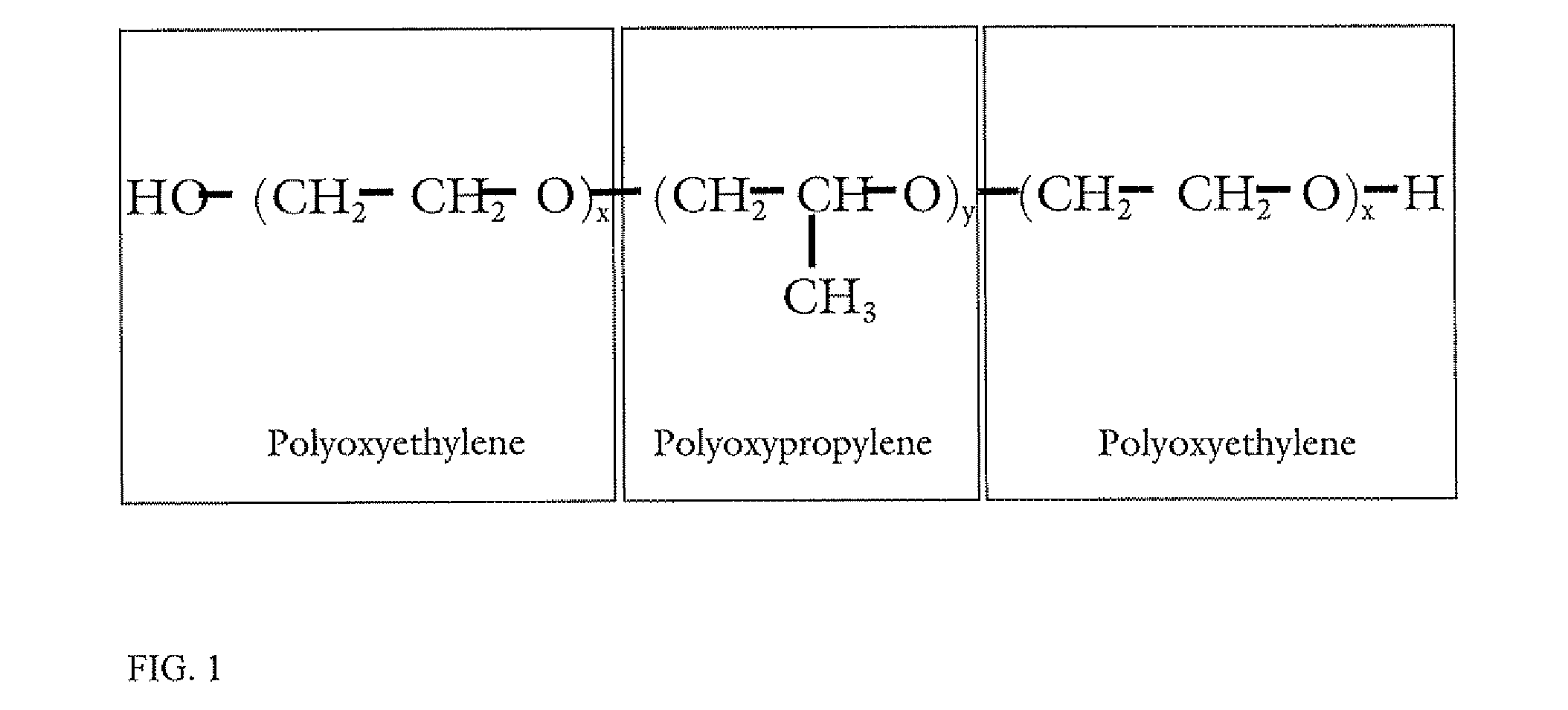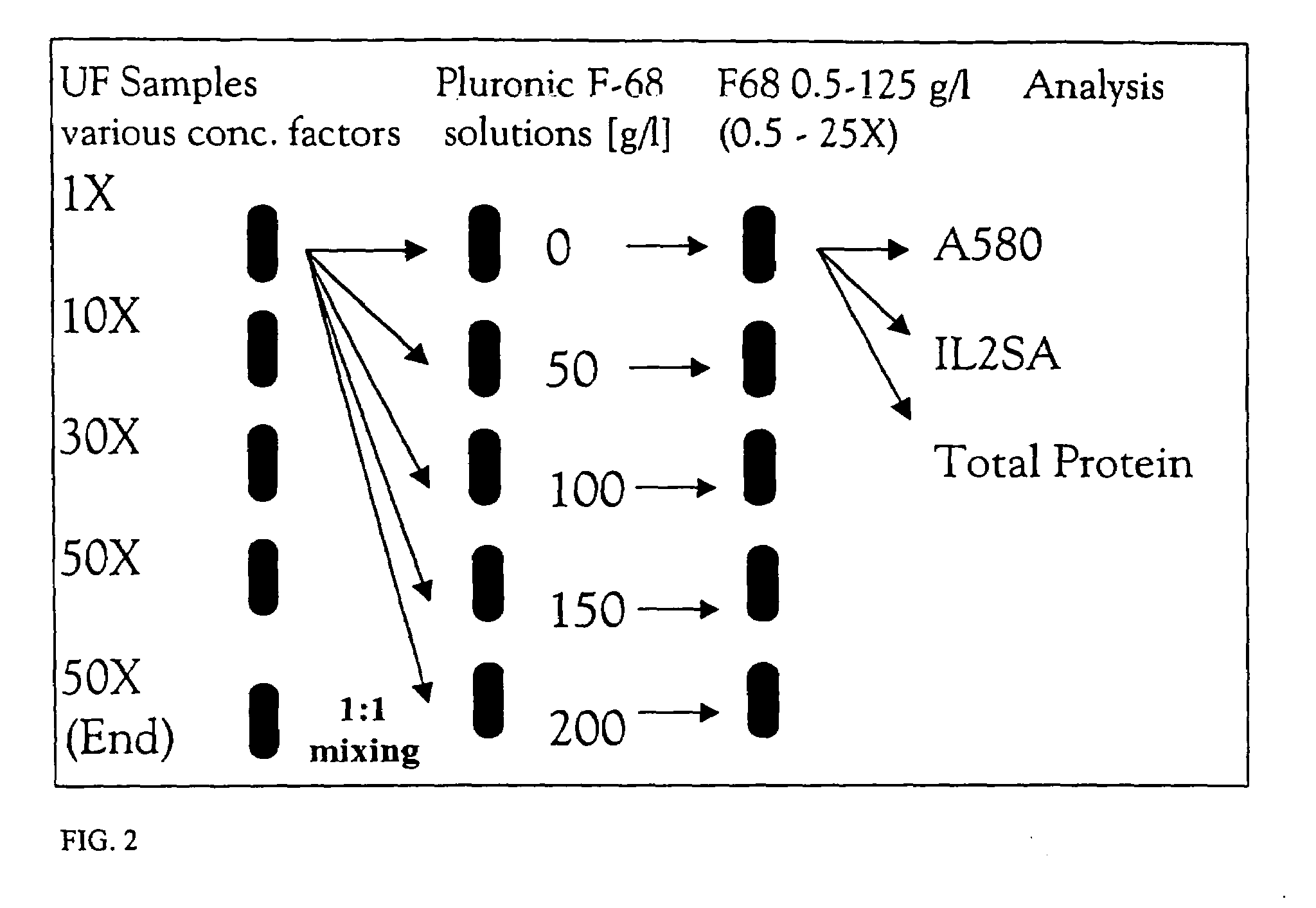Process for concentration of macromolecules
a macromolecule and solution technology, applied in the field of concentration of macromolecule solutions, can solve the problems of inability to achieve optimal protein concentrations for products from solutions, limited, and conventional cell culture based protein manufacturing processes are the attainable concentration factors of protein isolation
- Summary
- Abstract
- Description
- Claims
- Application Information
AI Technical Summary
Benefits of technology
Problems solved by technology
Method used
Image
Examples
example 1
Identification of Nature of Precipitate
[0054]Analysis of the precipitate formed during ultrafiltration concentration of cell culture supernatant by infrared spectroscopy clearly identifies protein as the main component of the precipitate.
[0055]A 25 fold concentrated harvest from IL-2SA fermentation was obtained. The supernatant was subjected to centrifugation and the pellet re-dissolved in PBS. The UF concentrated harvest, supernatant of 25 fold concentration and redissolved pellet were analyzed by SDS gel electrophoresis followed by silver staining (see FIG. 3a) and immuno-staining (ZAP analysis) with an anti-hIL-2SA-antibody (see FIG. 3b). From FIG. 3a, (4) it can be seen that the precipitate, which was at least partially re-dissolved in buffer, indeed contains significant amounts of protein. As can be seen from FIG. 3b, (4) some IL-2SA also precipitates. However, the amount of precipitated IL-2SA seems to be relatively low (compare 3b, (4) and (3)), which is consistent with the r...
example 2
Co-Concentration of PLURONIC F-68 Nonionic Block Copolymer
[0056]The average molecular weight of PLURONIC F-68 nonionic block copolymer is 8.4 kD, which is relatively large. Due to the formation of secondary membranes during ultrafiltration processes and the inherently inhomogeneous conditions along the crossflow channel, the selectivity of conventional UF technology does usually not allow significant separation of molecules in the size range of PLURONIC nonionic block copolymer. Even for 100 kD UF membranes, as used for the largest protein products like rFVIII or gp220 / 350, significant retention and co-concentration of polymers like PLURONIC F-68 nonionic block copolymer is usually found (see e.g. Schulz et al., 1997). It can be assumed that the retention coefficient R of PLURONIC F-68 nanionic block copolymer during the ultrafiltration process with, e.g., a 10 kD NMWCO (nominal molecular weight cut-off) will be close to 1 (or 100%). Since the PLURONIC F-68 nonionic block copolymer ...
example 3
Spiking Experiments with PLURONIC F-68 Nonionic Block Copolymer
[0059]Since it has been demonstrated that the end concentration of PLURONIC F-68 nonionic block copolymer in ultrafiltration retentate is usually very high, spiking experiments with culture supernatant and concentrates of different concentration factors were performed in order to characterize the influence of these higher PLURONIC F-68 nonionic block copolymer concentrations on protein solubility. As can be seen from FIG. 5, spiking PLURONIC F-68 nonionic block copolymer into samples of pre-concentrated culture supernatant indeed causes strong precipitation. As expected, the PLURONIC F-68 nonionic block copolymer induced precipitation appears to be more severe for a higher concentration factor. FIG. 6 shows the remaining total protein in solution as measured by the Bradford assay (after centrifugation) as a function of concentration factor and PLURONIC F-68 nonionic block copolymer concentration. These results are consis...
PUM
| Property | Measurement | Unit |
|---|---|---|
| conductivity | aaaaa | aaaaa |
| conductivity | aaaaa | aaaaa |
| conductivity | aaaaa | aaaaa |
Abstract
Description
Claims
Application Information
 Login to View More
Login to View More - R&D
- Intellectual Property
- Life Sciences
- Materials
- Tech Scout
- Unparalleled Data Quality
- Higher Quality Content
- 60% Fewer Hallucinations
Browse by: Latest US Patents, China's latest patents, Technical Efficacy Thesaurus, Application Domain, Technology Topic, Popular Technical Reports.
© 2025 PatSnap. All rights reserved.Legal|Privacy policy|Modern Slavery Act Transparency Statement|Sitemap|About US| Contact US: help@patsnap.com



